
Pecan Tree, Pecan Nut Tree: Planting and Growing
Contents
The Pecan Nut Tree in a Nutshell
- The pecan tree (Carya illinoinensis) is a fruit tree cultivated for its dried fruits: the pecan walnuts.
- This is a large fruit tree that can grow between 15 to 40 metres in height.
- Although hardy, it requires intense summer heat for its walnuts to ripen and will only bear fruit in Mediterranean climates.
- Plant two varieties to achieve a better harvest.
- It can be grown both as an ornamental tree and as a fruit tree.
The word from our expert
The pecan tree, in Latin Carya illinoinensis, is the fruit tree that produces pecan walnuts. Hardy down to -15°C, it can be planted in most of our regions, but fruit production will mainly occur in the South of France as it requires long, hot summers to bear fruit. It yields walnuts after 4 to 5 years of cultivation. Then you can enjoy brownies, tarts, or pecan walnut cakes! This is a large nut-bearing tree with deep roots, which can reach heights of 20 to 40 metres, but there are more compact varieties suitable for smaller gardens, such as ‘Choctaw’ or ‘Pawnee’. It forms a robust tree with dense shade, and its large pinnate leaves turn a beautiful golden hue in autumn before falling. Its attractive furrowed bark and spring flowering in long greenish aments are other highlights. It requires deep, moist to wet soil with a light texture. Partially self-fertile, it is advisable to plant two trees to ensure a good harvest.
Discover this long-lasting tree and how to enjoy bountiful pecan walnut harvests!
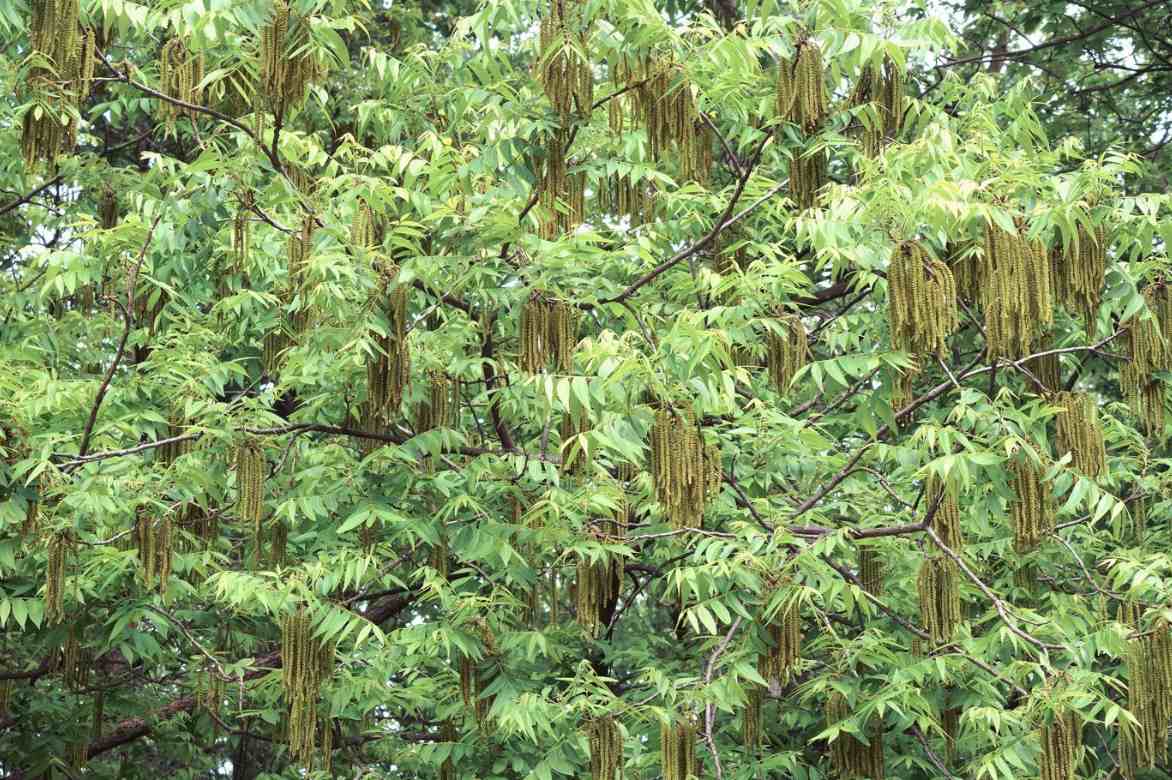
Carya illinoinensis in full flowering
Description and Botany
Botanical data
- Latin name Carya illinoinensis
- Family Juglandaceae
- Common name Pecan tree, Pecan walnut
- Flowering March to May
- Height 10 to 40 m
- Exposure Sun
- Soil type Clay-loam (rich and light), fresh, well-drained
- Hardiness -15 °C/-20°C
The Carya illinoinensis, pecan tree or pecan walnut, is a fruit tree from the Juglandaceae family, much like the walnut (Juglans regia). It is native to the humid forests and swamps of North America, specifically Illinois, Kansas, Missouri, Texas, Virginia, Kentucky, and northern Mexico. Despite its good hardiness, its cultivation is best suited to Mediterranean regions as it requires long, hot summers to bear fruit. The genus Carya includes 25 species, of which the most cultivated is Carya illinoinensis, which produces delicious pecan nuts. This species has given rise to various varieties such as ‘Choctaw’, ‘Delmas’, ‘Amling’, ‘Gloria Grande’, ‘Amling’, or ‘Sumner’, whose growth, productivity, nut size, precocity, and disease resistance vary.
The pecan tree is a large tree with deep roots. Its growth is relatively fast, and it forms a beautiful tree with an upright habit and a rounded crown. It can reach heights of 20 to 40 m and widths of 10 to 15 m, with a trunk circumference of up to 6 m. Some varieties, such as ‘Mohawk’, have a more modest growth, reaching around 15 m in height. The grey, furrowed bark is decorative and peels into strips over time.
The pecan tree or pecan walnut has deciduous foliage. The alternate, odd-pinnate leaves, borne on long petioles, can measure up to 50 cm in length and consist of 9 to 13 oblong leaflets. Green in spring, they turn golden in autumn just before falling. They emit a somewhat unpleasant odour when crushed.
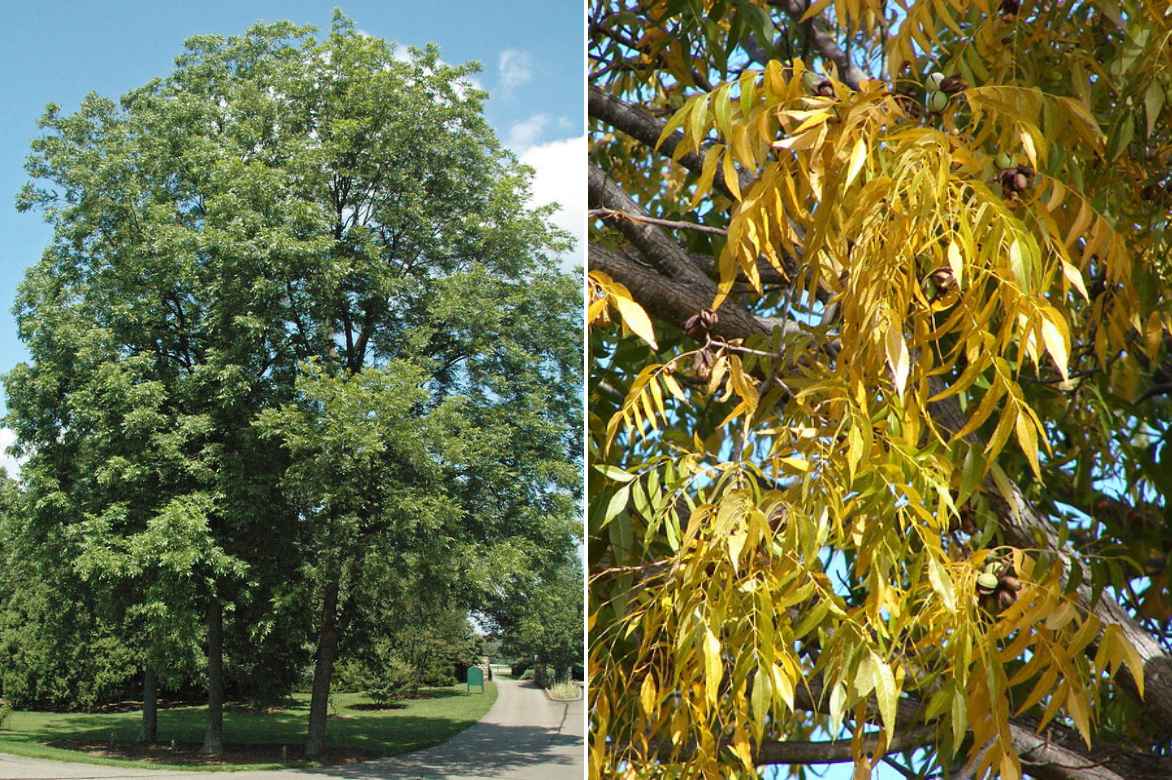
Carya illinoinensis: habit (© James St John) and autumn foliage (© Forest and Kim Starr)
Flowering is prominent in spring, from March to May. It occurs in two stages. Just before the leaves emerge, in late March, long, pendulous yellow-green male catkins, measuring up to 15 cm in length, appear hanging along the branches. They consist of small flowers with six petals.
Later, inconspicuous female flowers emerge in small, upright spikes at the tips of young shoots. These are heavily visited by pollinating insects, which fertilise them freely. However, this fruit tree is partially self-fertile, and it is preferable to have two trees to ensure effective cross-pollination, as the male catkins do not mature at the same time as the female flowers. Fruiting begins around the 4th or 5th year. It is a biennial-bearing tree, producing nuts every other year.
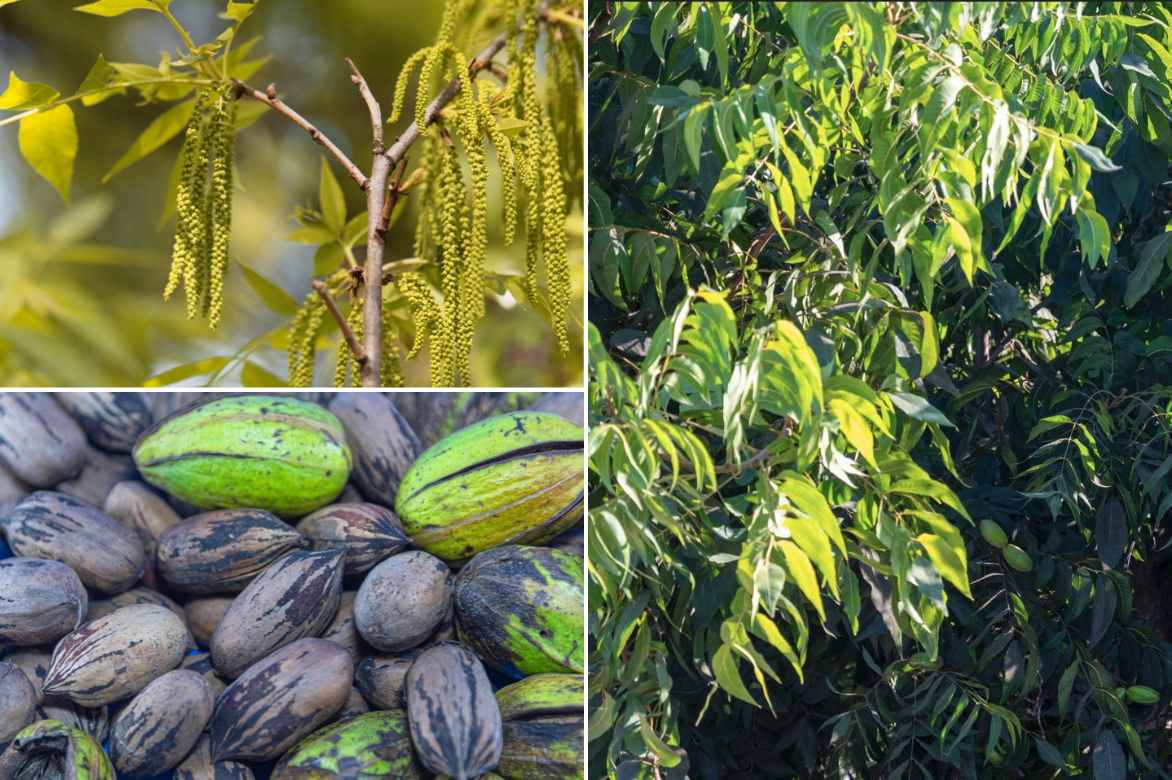
Flowering, foliage, and fruit of Carya illinoinensis
After fruiting, the tree produces oblong, fleshy drupes, 4 to 6 cm long, green in colour, turning brown at maturity, called husks. These inedible, dehiscent drupes are grouped in clusters of 2 to 10. They split open at maturity into four valves to release a smooth, elongated shell, brown in colour. Inside this shell, once cracked, lies a bilobed almond measuring 3 to 6 cm in length, edible and delicious: the pecan nut, also called pacane or hickory nut. It contains white flesh, covered by a thin reddish-brown skin. The size of the nuts varies depending on the variety. Harvesting takes place from August to November. These smooth kernels have a taste similar to walnuts and almonds, but without the bitterness of traditional nuts. Their flavour is more refined and less astringent.
The United States and Mexico account for nearly 95% of the world’s pecan nut production. The pecan tree is cultivated both for its fruit and for its high-quality wood, used for veneer.
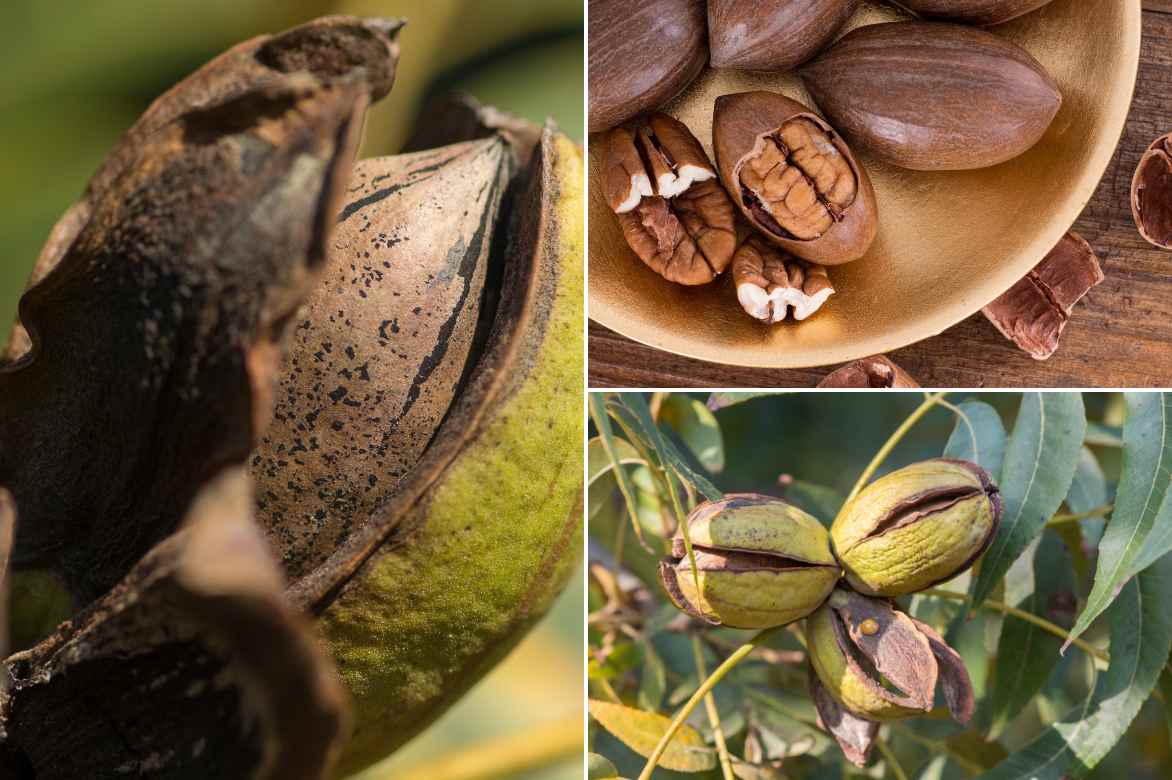
Husks and pecan nuts
Main species and varieties
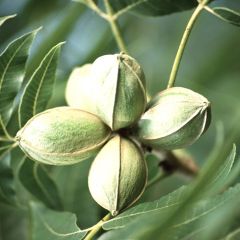
Carya illinoinensis
- Flowering time April to June
- Height at maturity 30 m
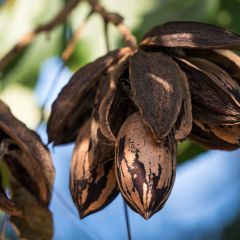
Carya illinoinensis Choctaw - Pecan Tree
- Flowering time June, July
- Height at maturity 15 m

Carya illinoinensis Delmas - Pecan Tree
- Flowering time June, July
- Height at maturity 15 m
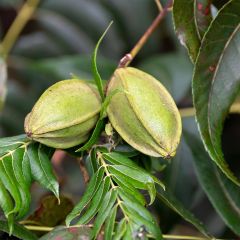
Carya illinoinensis Mohawk - Pecan Tree
- Flowering time June, July
- Height at maturity 15 m

Carya illinoinensis Pawnee - Pecan Tree
- Flowering time June, July
- Height at maturity 10 m
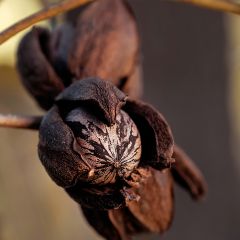
Carya illinoinensis Shoshoni - Pecan Tree
- Flowering time June to August
- Height at maturity 15 m
Discover other Pecan trees
View all →Available in 1 sizes
Available in 1 sizes
Available in 1 sizes
Available in 2 sizes
Available in 1 sizes
Available in 1 sizes
Planting the Pecan Tree
Where to Plant a Pecan Tree?
Hardy down to -15°C, or even -20°C depending on the variety, the pecan tree can be grown anywhere in France as an ornamental tree. However, to produce fruit in our latitudes, it is best to reserve its cultivation for Mediterranean regions. It will not thrive north of the Loire. This is a fruit tree that grows better in warm climates. However, it requires both fairly cold winters to induce flowering and long, hot summers followed by mild autumns for its walnuts to ripen, at least 6 to 7 months without frost. Nevertheless, newer varieties can cope with shorter and cooler summers.
The pecan tree appreciates semi-moist soils and grows naturally in fertile, well-drained floodplains. It has fairly high water requirements in summer. If the summer is too dry, you will need to water it accordingly, although once well established, its taproot allows it to draw moisture from deep within the soil.
Plant it in a very sunny location in rich, moist to wet, well-drained soil, or even sandy soil so it can spread its roots. Quite demanding, it dislikes prolonged droughts and neither dry nor overly chalky soils, preferring a slightly acidic substrate with an ideal pH between 4.5 and 7.5.
It naturally fits in an irrigated orchard in the Mediterranean zone but also in an ornamental garden as a standalone specimen in a short grass meadow thanks to its elegant silhouette and spring flowering. Given its size at maturity, allocate a space that matches its significant growth. The largest specimens are best suited to large wooded gardens or parks. And think carefully about its location because its taproot dislikes transplanting.
Growing in a very large pot is possible, though it will naturally remain smaller in this case and is very unlikely to bear fruit. You will enjoy its ornamental qualities more than its fruit.
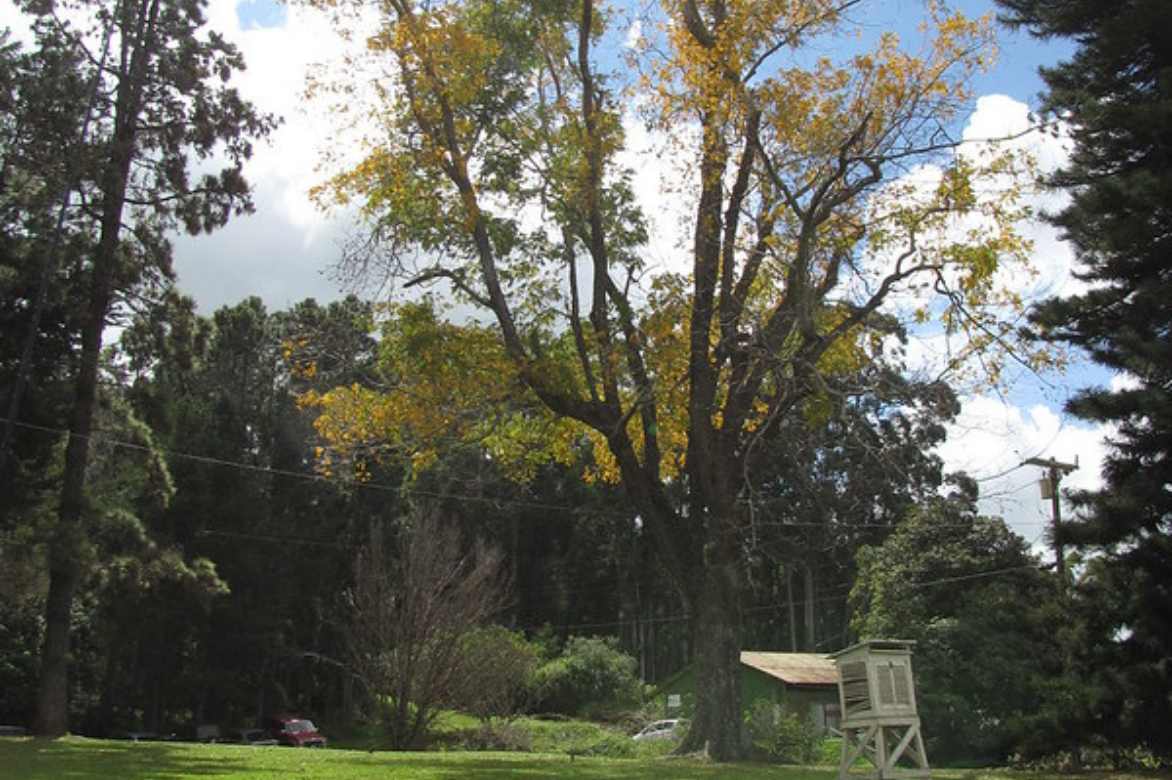
A magnificent pecan tree in a large garden (© Forest and Kim Starr)
When to Plant the Pecan Tree?
Planting is best done in spring, between February and May, outside of frost periods.
How to Plant It?
In the Ground
Its powerful root system means the soil should be well-prepared to a depth of about 1 m and equally in width. Maintain a distance of 10 to 50 m between two pecan trees or other trees, depending on their mature size.
- Soak the root ball in a basin of water
- Dig a planting hole 1 m in all directions
- Mix 1/3 heather soil, 1/3 horticultural sand, and 1/3 garden soil
- Add a few shovelfuls of sand and gravel to ensure good drainage around the roots
- In overly acidic soil, add dolomite or ash
- Pour part of the mixture into the hole
- Insert a stake and tie the trunk with a flexible tie to support it for the first few years
- Place the root ball without damaging the taproot, leaving the collar level with the soil surface
- Fill the gaps with the remaining mixture
- Firm the soil and water generously
- Mulch the base
My tip: topping the tree at this stage, by pruning a third of its top, will encourage the development of new roots.
In a Pot
- Choose a container with drainage holes, holding at least 100 litres (1 x 1 m)
- Add a drainage layer (coarse sand, clay pebbles, pumice)
- Partially fill the pot with good horticultural compost mixed with horticultural sand
- Place the root ball and fill around the roots with compost
- Firm the surface well
- Water generously
Cultivation and Care of the Pecan Tree
Robust and vigorous, the pecan tree requires very little care to thrive, apart from regular watering, especially during droughts and heatwaves. It needs a lot of water. For the first 6 months after planting, watering should be very consistent and regular: provide it with between 30 and 50 litres of water per week. Later, when the tree begins to bear fruit, after 5 years of cultivation, watering becomes essential: ensure it is watered generously every day so that the walnuts ripen.
Spread a thick layer of mulch made from dead leaves, straw, wood chips, or partially decomposed compost to prevent weed competition, keep the roots cool in summer and warm in winter.
Apply organic fertiliser in spring, such as well-rotted compost by lightly scratching the surface, or a special fruit tree fertiliser. Pruning is not necessary.
Diseases and potential pests
Hardy, it is primarily susceptible to certain fungal diseases such as powdery mildew, or bacterial leaf scorch that affects the foliage. As a preventive measure: spray the leaves with Bordeaux mixture after rainfall. It can also be affected by crown gall, which impacts the entire root system, though fortunately new cultivars show resistance to these diseases.
When and how to harvest pecan walnuts?
You will need to wait 4 to 5 years for the pecan tree to bear fruit after planting. The harvest spreads from mid-August to mid-November, more commonly around November, depending on the earliness of the variety, the summers, and your region. Pecans are simply harvested by hand or they will be shaken to dislodge the fruits from the branches.
→ Learn more in our tutorial Harvesting and Storing Pecans: Our Tips.
Preserve pecans and use them.
Dried pecan nuts can be stored for about a year, just like walnuts. Freshly shelled pecans quickly turn rancid when exposed to air. You can keep them in airtight jars at room temperature or refrigerate them for 6 months in sealed containers. Alternatively, you can freeze them in freezer bags, where they will last for a year, though the cold may diminish their flavour.
They can be enjoyed fresh or dried on racks, arranged in a single layer in a cool, dry, and well-ventilated place. Pecans can be used as halves, caramelised, roasted, ground, blanched, or as oil. They are perfect as a snack for aperitifs, as a treat, or in pastries. They add a delightful crunch to the famous pecan pie. They pair wonderfully with chocolate in brownies and cookies!
→ Learn more in Solenne’s tutorial: Harvesting and Storing Walnuts

Pecan pie or brownies, appetisers… in the kitchen, they’re perfect for sweet or savoury dishes!
What are the benefits of pecan nuts?
This oleaginous shell fruit is rich in lipids, particularly in polyunsaturated fatty acids such as omega-9 (oleic acid) and omega-6 (linoleic acid). Pecan walnuts have a low glycemic index and a low sugar content. Packed with potassium, magnesium, zinc, and phosphorus, they are a real anti-fatigue cocktail, good for immunity and the balance of the nervous system. Rich in antioxidants, they reduce cholesterol levels and prevent cardiovascular complications. They are energy-dense and contain approximately 700 kcal per 100 grams.
How to propagate Carya illinoinensis?
Sowing in spring is the easiest way to propagate the Pecan tree, but you will need to wait 10 to 12 years to harvest fruits. The tree can also be propagated by shield grafting in summer. This is a relatively delicate operation for amateur gardeners, and we recommend leaving it to professionals.
By sowing
- Fill deep pots with a light mixture composed of 1/3 heather soil, 1/3 loam, and 1/3 perlite
- Sow the pecan seeds on the surface, then cover them with 2 to 3 cm of substrate
- Keep covered at 20°C until germination
- Remove the plastic
- Repot into a larger pot and then transplant into the garden once the young plant is well-rooted
Useful resources
- Discover our advice sheet on the Pecan Tree: growing it to harvest pecan walnuts
- Discover our advice sheet: Growing shell fruits in the garden
- Grow nut trees such as the almond tree (The Almond Tree: planting, pruning and harvesting), the hazelnut tree (Choosing the right hazelnut tree: a buying guide) or the walnut tree (Walnut Tree, Juglans regia: planting, pruning and care)
- Subscribe!
- Contents

































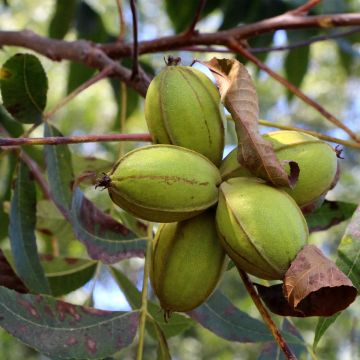



Comments